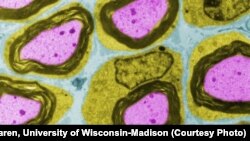Scientists at the University of Wisconsin have found a way to coax peripheral nerve cells into repairing damaged axons. Peripheral cells extend outside the central nervous system into the arms and legs and are responsible for sensation. They contain long fibers known as axons that transmit impulses from the brain. They can be damaged in diseases such as diabetes, causing pain.
The axons are surrounded by a protective sheath called myelin, a fatty insulation that speeds electrical signals from the brain. Myelin is created by Schwann cells, but researchers have discovered that Schwann cells can also stimulate nerve regrowth.
They conducted an experiment in mice with both intact axons and axons which had been cut. Using a method for switching on genes, they saw Schwann cells become more active, but only in the injured rodents.
They went into a repair mode that stimulated nerve regrowth. This clean-up, as researchers call it, began within days of the injury.
As part of the clean-up process, the Schwann cells send signals that enlist blood cells to help in the repair. During this time, the myelin begins to dissolve to make room for the axonal repair. After the axons are on the road to recovery, a new myelin sheath begins to form over the regenerated fibers.
The scientists identified a particular pathway that switches the Schwann cells on or off. They suggest drugs may some day be available to activate the repair program.
A report on axonal regeneration was published in The Journal of Neuroscience.
Lead researcher John Svaren, a professor of comparative biosciences at the University of Wisconsin, says it’s not clear that this single on-off pathway works to regenerate all axonal nerve cell damage. But he’s hopeful that it’s a key repair mechanism, not only within the peripheral nervous system but for nerve damage within the brain.
Until now, Svaren says scientists have thought of the Schwann cell as a “static entity,” with only one function: producing myelin. But he is excited that the cells can be coaxed to become “first responders” in helping to repair the peripheral nervous system.






